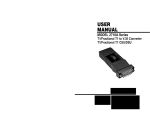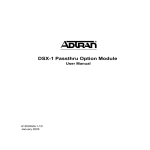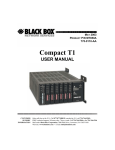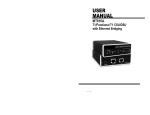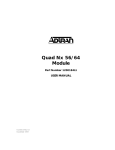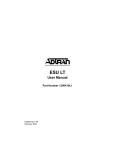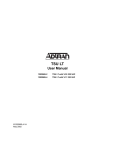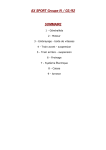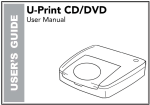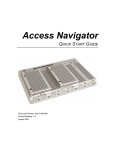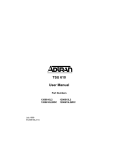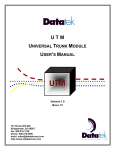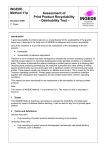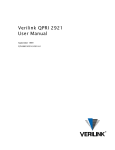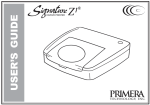Download Model 2090
Transcript
USER MANUAL MODEL 2090 Series FT1 to V35 Interface Converter Part# 07M2090-C Doc# 077291UC Revised 05/03/00 CERTIFIED An ISO-9001 Certified Company SALES OFFICE (301) 975-1000 TECHNICAL SUPPORT (301) 975-1007 http://www.patton.com TABLE OF CONTENTS Section 1.0 GENERAL INFORMATION Page 1.0 General Information...............................................................2 1.1 Warranty Statement 1.2 CE Notice 1.3 Radio and TV Interference 1.4 Service 2.0 General Information ..............................................................6 2.1 Features 2.2 General Product Description 2.3 Supported Applications 3.0 Configuration..........................................................................8 3.1 Configuration Using DIP Switches 3.1.1 DIP Switches SW1 and SW2 4.0 Installation ..........................................................................15 4.1 DTE Interface Connection 4.2 Network Interface Connection 4.3 Power Connection 5.0 Operation .............................................................................16 5.1 LED Descriptions 5.2 Central Office Loops Appendix A - Specifications ........................................................19 Appendix B - Cable Recommendations......................................20 Appendix C - Factory Replacement Parts and Accessories ......21 Thank you for your purchase of this Patton Electronics product. This product has been thoroughly inspected and tested and is warranted for One Year parts and labor. If any questions or problems arise during installation or use of this product, please do not hesitate to contact Patton Electronics Technical Support at (301) 975-1007. 1.1 WARRANTY STATEMENT Patton Electronics warrants all Model 2090 Series components to be free from defects, and will—at our option—repair or replace the product should it fail within one year from the first date of shipment.This warranty is limited to defects in workmanship or materials, and does not cover customer damage, abuse, or unauthorized modification. This product contains no serviceable parts; therefore the user shall not attempt to modify the unit in any way. If this product fails or does not perform as warranted, your sole recourse shall be repair or replacement as described above. Under no condition shall Patton Electronics be liable for any damages incurred by the use of this product. These damages include, but are not limited to, the following: lost profits, lost savings and incidental or consequential damages arising from the use of or inability to use this product. Patton Electronics specifically disclaims all other warranties, expressed or implied, and the installation or use of this product shall be deemed an acceptance of these terms by the user. In the event the user detects intermittent or continuous product malfunction due to nearby high power transmitting radio frequency equipment, the user is strongly advised to use only data cables with an external outer shield bonded to a metal or metalized connector. Appendix D - Interface Pin Assignments ....................................22 Appendix E - Power Supply Interface ........................................24 1.2 CE NOTICE The CE symbol on your Patton Electronics equipment indicates that it is in compliance with the Electromagnetic Compatibility (EMC) directive and the Low Voltage Directive (LVD) of the Union European (EU). A Certificate of Compliance is available by contacting Patton Technical Support. WARNING! This device is not intended to be connected to the public telephone network. 1 2 1.3 RADIO AND TV INTERFERENCE The Model 2090 Series generates and uses radio frequency energy, and if not installed and used properly—that is, in strict accordance with the manufacturer's instructions—may cause interference to radio and television reception. The Model 2090 Series has been tested and found to comply with the limits for a Class A computing device in accordance with the specifications in Subpart J of Part 15 of FCC rules, which are designed to provide reasonable protection from such interference in a commercial installation. However, there is no guarantee that interference will not occur in a particular installation. If the Model 2090 Series does cause interference to radio or television reception, which can be determined by disconnecting the cables, the user is encouraged to try to correct the interference by one or more of the following measures: moving the computing equipment away from the receiver, re-orienting the receiving antenna, and/or plugging the receiving equipment into a different AC outlet (such that the computing equipment and receiver are on different branches). 3 This page intentionally left blank. 4 2.0 GENERAL INFORMATION 1.4 SERVICE All warranty and non-warranty repairs must be returned freight prepaid and insured to Patton Electronics. All returns must have a Return Materials Authorization number on the outside of the shipping container. This number may be obtained from Patton Electronics Technical Support at: tel: (301) 975-1007; email: [email protected] www: http://www.patton.com. NOTE: Packages received without an RMA number will not be accepted. Patton Electronics' technical staff is also available to answer any questions that might arise concerning the installation or use of your Patton Model 2090. Technical Service hours: 8AM to 5PM EST, Monday through Friday. Thank you for your purchase of this Patton Electronics product. This product has been thoroughly inspected and tested and is warranted for One Year parts and labor. If any questions arise during installation or use of the unit, contact Patton Electronics Technical Services at (301) 975-1007. 2.1 FEATURES • • • • • • • • Operates over 4-Wire T1 (DS1) Circuits Supports Unstructured Rates at 1.544 Mbps Supports Common Framed nx56/64 rates up to 1.536 Mbps Seven Easy-to-Read LED Indicators Monitor Data & Diagnostics Internal or Receive Loopback Clocking Also Works as a High-Speed Point-to-Point Modem Compact Size Plugs Directly into a Router, Switch or other DTE Made in USA 2.2 GENERAL PRODUCT DESCRIPTION The Model 2090 Series T1/FT1 to V.35 Interface Converters continue Patton’s tradition of high quality, miniature access products. The Model 2090 Series plugs directly into the WAN port of a switch, router or multiplexer. The Model 2090 converts the V.35 signals to a single T1 or FT1 connection at data rates of 1.544 Mbps (unstructured), nx64, and nx56 (n=1, 2, 3,....24). Moreover, the starting channel can be set to any value from 1 to 24. It’s a great way to connect high speed data, video, or audio directly to T1/FT1. The Model 2090 Series is easily configurable using pc-board mounted DIP switches. Use the DIP switches to set D4 and ESF framing modes, AMI or B8ZS line coding, clocking modes, Line Build Out, Data Rate, and starting channel. Connecting directly to the V.35 interface, the ultra-compact Model 2090 attaches without using additional cables. Twisted-pair line connections are facilitated by a modular RJ-48C jack on the rear of the unit. Seven easy-to-read LED indicators monitor data, network, test signals, and proper setup. Model 2090 is available for 120 VAC or 100240 VAC Universal Interface (UI), or even DTE Interface power operation. 5 6 3.0 CONFIGURATION 2.3 SUPPORTED APPLICATION The Model 2090 allows equipment with V.35 interfaces to connect directly to a T1/FT1 access port. The 2090 can also be used as a high-speed short haul modem for campus applications. Before placing the Model 2090 into service, the unit must be configured to match both the DTE and T1 interface parameters. Configuration is accomplished using pc board mounted DIP Switches. 3.1 CONFIGURATION USING DIP SWITCHES 2.3.1 The 2090 as the Interface between the Telco and CPE The Model 2090 Series provides T1/FT1 connectivity between a router and a spare port on a Frame Relay Switch (See below). Configure the Model 2090 using a DIP switch package located on the bottom side of the printed circuit board (See Figure 1, below). DIP Switches SW1 & SW2 Model 2090 Frame Relay Switch Router ON ON ON ON 1 T1 Network LAN OFF 2 3 4 5 1 2 3 4 5 6 7 8 6 7 8 1 2 SW2 3 4 5 6 7 8 SW1 1.544Mbps or nx56/64 Extra T1/FT1 Port 2.3.2 The 2090 as a High-Speed Short Range Modem Figure 1. Model 2090 Series bottom view, showing location of DIP switches The Model 2090 Series can also be installed into high-speed campus applications. In this application, a pair of Model 2090 Series units operate as short range modems (See below). The Model 2090 DIP switches can be configured as either “On” or “Off”. Figure 2 (below) shows the orientation of the DIP switches with respect to ON/OFF positions. Model 2090s Bridge/Router LAN PWR T/L ALM LOS RXD TXD ERR 1.544MBps or nx56/64 1 2 3 4 5 7 8 OFF PWR T/L ALM LOS RXD TXD ERR Model 2700 7 6 Figure 2. Close up of DIP switches showing ON/OFF positions. Bridge/Router LAN ON ON Model 2700 8 3.1.1 DIP Switches SW1 and SW2 Switches SW1.8, SW1.7, SW1.6, SW1.5 & SW1.4 The configuration switches on the DIP switch pack will allow you to specify data rates, line framing and coding, DSO rate, clock mode and Line Build Out (LBO). Factory default settings of all switches are shown in the table below. These switches set the DTE date rate. Each setting represents an nx56/nx64 setting. The chart below shows the switch settings and the acheived DTE data rate. SWITCH SETTING SUMMARY TABLE Position SW1.8 SW1.7 SW1.6 SW1.5 SW1.4 SW1.3 SW1.2 SW1.1 SW2.8 SW2.7 SW2.6 SW2.5 Function Data Rate Data Rate Data Rate Data Rate Data Rate Starting Channel Starting Channel Starting Channel Starting Channel Starting Channel Line Build Out Line Build Out Factory Default On On Off Off Off Off Off Off Off Off Off Off SW2.4 SW2.3 SW2.2 SW2.1 Line Code Frame DS0 Rate/Clock* Clock Off Off On Off MODEL 2090 DTE DATA RATE Selected Option 1.536 Mbps (DTE Rate) Starting From Channel 1 0dB B8ZS ESF 64 kbps Network * In unframed mode, SW2.2 is used with SW2.1 to determine the clocking mode. In framed modes (ESF or D4) only network and internal clocking are available. In unframed mode, where the DTE data rate is 1.544 Mbps, a third clocking option is available-external clocking, in which the 2090 derives its transmit timing source from the DTE (See Appendix D for external timing pin data). SW1.8 Off Off Off Off Off Off Off Off Off Off Off Off Off Off Off Off On On On On On On On On On SW1.7 Off Off Off Off Off Off Off Off On On On On On On On On Off Off Off Off Off Off Off Off On SW1.6 Off Off Off Off On On On On Off Off Off Off On On On On Off Off Off Off On On On On Off SW1.5 Off Off On On Off Off On On Off Off On On Off Off On On Off Off On On Off Off On On Off SW1.4 Off On Off On Off On Off On Off On Off On Off On Off On Off On Off On Off On Off On Off DTE Data Rate 1544 kbps (unframed) 56/64 kbps (n=1) 112/128 kbps (n=2) 168/192 kbps (n=3) 224/256 kbps (n=4) 280/320 kbps (n=5) 336/384 kbps (n=6) 392/448 kbps (n=7) 448/512 kbps (n=8) 504/576 kbps (n=9) 560/640 kbps (n=10) 616/704 kbps (n=11) 672/768 kbps (n=12) 728/832 kbps (n=13) 784/896 kbps (n=14) 840/960 kbps (n=15) 896/1024 kbps (n=16) 952/1088 kbps (n=17) 1008/1152 kbps (n=18) 1064/1216 kbps (n=19) 1120/1280 kbps (n=20) 1176/1344 kbps (n=21) 1232/1408 kbps (n=22) 1288/1472 kbps (n=23) 1344/1536 kbps (n=24) Notes: 1. SW2.2 is used to set the DS0 rate to 56 kbps or 64 kbps. 2. For unframned operation, 1544 kbps, set SW1.8, SW1.7, SW1.6, SW1.5 & SW1.4 to OFF 9 10 Switches SW1.1 SW1.2, SW1.3, SW 2.7 & SW2.8 Switches SW2.6 & SW2.5 Line Build Out These switches set the starting channel. The starting channel is the first channel that carries valid data. This channel can be set to any value between 1 and 24. All additional channels are arranges in contiguous order. If the starting channel is other than 1, then the maximum possible bandwidth will be less than 1536 kbps. For example, if the starting channel is set to be 12, then the maximum bandwidth is limited to 13x64 kbps (channels 12~24), or 832 kbps. This must be kept in mind when setting the starting channel. The Model 2090 will flash the ERR indicator LED if the switch setting is invalid. Refer to section 5.1 for a more detailed explanation of the ERR LED function. These switches are used to set the line build out (LBO). The LBO controls the pulse shape and attenuation of the signal sent to the network. The amount of LBO depends on the length of cable used on the T1 side. SW2.6 Off Off On On SW2.5 Off On Off On LBO 0 dB, 0-133 ft -7.5 dB -15.0 dB -22.5 dB T1 STARTING CHANNEL T1 Starting Channel SW1.3 SW1.2 SW1.1 SW2.8 SW2.7 (maximum value of n) Off Off Off Off Off 1 (24) Off Off Off Off On 2 (23) Off Off Off On Off 3 (22) Off Off Off On On 4 (21) Off Off On Off Off 5 (20) Off Off On Off On 6 (19) Off Off On On Off 7 (18) Off Off On On On 8 (17) Off On Off Off Off 9 (16) Off On Off Off On 10 (15) Off On Off On Off 11 (14) Off On Off On On 12 (13) Off On On Off Off 13 (12) Off On On Off On 14 (11) Off On On On Off 15 (10) Off On On On On 16 (9) On Off Off Off Off 17 (8) On Off Off Off On 18 (7) On Off Off On Off 19 (6) On Off Off On On 20 (5) On Off On Off Off 21 (4) On Off On Off On 22 (3) On Off On On Off 23 (2) On Off On On On 24 (1) 11 Switch SW2.4 Line Coding This switch is used to set the line code. There are two line coding options available through the DIP switches: B8ZS and AMI. The line code refers to the way that the signal-the sequence of ones and zeros sent to the T1 equipment-is encoded. AMI reverses the polarity of consecutive pulses. B8ZS is identical to AMI, except that, under certain circumstances, the alternate polarity rule is deliberately violated. AMI: This stands for "Alternate Mark Inversion." The 2090 transmits data as a sequence of ones and zeros. Ones are usually sent as pulses, and zeros as spaces (no pulse). In order to maximize transmission range, every pulse is of the opposite polarity of the preceding pulse. AMI does nothing else. Maintaining network integrity requires a minimum pulse density (ones desity) of the signal being transmitted on the network. AMI does not inherently provide for this feature. Thus, if a long sequence of zeros happen to be sent, the network may suffer. To meet this requirement using AMI requires one of two methods: Reduce the rate of each time slot (DS0) to 56 kbps, so that the last bit can be used to guarantee the minimum ones density. Or, make sure that the DTE sends data in such a way that ones density is always maintained. For this reason, B8ZS may be preferred over AMI. 12 B8ZS: This stands for "Bipolar 8 Zero Substitution." This line code ensures minimum ones density. Long sequences of zeros are specially encoded. This line code allows any data pattern to be transmiited without causing ones density problems. Thus, it allows the use of 64 kbps timeslots. SW2.4 Off On Line Code B8ZS AMI Switch SW2.2 DS0 Channel Rate This switch is used to set the DS0 rate in framed modes; in unframed mode, this switch is used with SW2.1 to set the clocking mode. SW2.2 Off On DS0 Rate 56 kbps 64 kbps Switch SW2.1 Clock Mode Switch SW2.3 Line Framing This switch is used to set the frame. There are three framing modes available in the Model 2090 Series: ESF, D4 and Unframed. When SW1.8~SW1.4 are turned off, the unit is set to unframed operation, and SW2.3 is ignored. Otherwise, SW2.3 is used to set the frame to either ESF or D4. SW2.3 Off On Frame ESF D4 This switch is used to select the timing source for transmitting data to the T1 port. External clocking is available only in unframed mode (DTE data rate of 1544 kbps). CLOCKING AND FRAMING MODES Function Framed Mode (ESF/D4) Unframed Mode SW2.2 SW2.1 Clocking Mode Don’t Care Don’t Care Don’t Care Off On Off On Off On On Network Internal Network Internal External Note: 1. For unframed operation, 1544 kbps, set SW1.8, SW1.7, SW1.6, SW1.5 & SW1.4 to OFF. 2. For unframed operation, SW2.3 is ignored. NOTE: When using the Model 2090 to terminate a T1 port, the 2090 must be set to network clock. When using the Model 2090 as a high-speed short range modem, one unit of the link must be configured for Internal Clock mode, and the unit on the oppo site end must be configured for Network Clock mode. Line Framing Options D4/Superframe: The D4 framing format, as specified in AT&T TR62411 is the standard in which twelve frames make up a superframe. All signaling and synchronization is done in-band. Extended Superframe: Extended Superframe, as specified in AT&T TR 54016, consists of twenty-four (24) T1 frames. The framing bits are now used for framing, CRC and the Facility Data Link (FDL). The FDL allows maintenance messages and information to be passed between the 2090 and the Central Office. 13 14 4.0 INSTALLATION The Model 2090 is equipped with a DTE, network, and power interface. This section briefly describes connection to each. 4.1 DTE INTERFACE CONNECTION The DTE interface is a V.35 DCE presented as an M/34 male connector. This interface is designed to plug directly into a DTE interface (See Appendix D for V.35 interface pin assignments). 5.0 OPERATION Once the Model 2090 is installed and configured properly it is ready to place into operation. This section describes the function of the LED indicators, the use of the loopback test modes and the control port. 5.1 LED DESCRIPTIONS The Model 2090 Series is equipped with seven LED indicators that monitor the status of communication. Figure 3 (below) shows the location of the LEDs on the Model 2090 Series front panel. 4.2 NETWORK INTERFACE CONNECTION The Network Line Interface is an eight position keyed modular jack configured as a RJ-48C. This interface will need to be configured to match the line parameters (i.e. framing, line coding) supplied by the connected equipment. NOTE: If the Model 2090 Series is being used for private short range modem applications, the twisted pair cable connected to its port will need to be a cross-over cable. See Appendix D for Interface pin assignments. TXD LOS ALM 4.3 POWER CONNECTION ERR T/L Model 2711 Model 2090 RXD PWR The Model 2090 Series is powered via a supplied external transformer and is factory configured for either 120VAC or 100-240VAC operation. This connection is via the barrel jack on the rear of the 2090. The Model 2090 can also be powered via the DTE interface when supplied with +5VDC @ 300mA to Pin KK. See Appendix D for more information. Figure 3. Top of Model 2090, Showing LED Indicators 15 TXD (Transmit Data) glows green to indicate data flow to Model 2090 from the DTE. RXD (Receive Data) glows green to indicate data flow from the Model 2090 to DTE. LOS (Loss of Sync) glows red to indicate a network Loss of Frame or Loss of Signal condition. 16 ALM (Alarm) glows red to indicate that one of several alarm conditions exist. These conditions may be local alarms or remote alarm conditions. Alarms may occur due to: • Loss of Synchronization • Loss of Frame • AIS (Blue Alarm) • Yellow Alarm ERR (Error) flashes to indicate errors. There are several flashing patterns to indicate the type of error. Invalid Switch Configuration: It is possible to request more bandwidth than is possible. For instance, if you set the starting channel to 12, and you select a number of timeslots exceeding 13, the unit will not be able to satisfy your request. In that case, the ERR LED will flash once a second (½ second on, ½ second off). When the unit detects an invalid setting, it will ignore the setting and default to a full T1 (bandwidth = 24 channels, starting channel = 1). This will continue until you set the switches to a valid setting. The invalid switch configuration condition overrides other error conditions. 5.2 CENTRAL OFFICE LOOPS The 2090 also responds to central office initiated loop commands. When in D4 framing mode, the 2090 will implement the “loop up” command when it recognizes the pattern “10000” in the data stream for a minimum of 5 seconds. The “loop down” command is implemented by the pattern “100” in the data stream for a minimum of 5 seconds. When operating in ESF framing mode, loopback commands are issued via the Facility Data Link (FDL). The line loop message will cause a loop back before data enters the framer portion of the converter. The payload loop message will cause the 2090 to loop data after the framer portion of the converter. The 2090 will respond to Universal Loopback Deactivate to clear all central office loops. • Errored Second: In ESF or SF framing, if the unit detects a frame error, the ERR LED will flash briefly once a second. • Framing Mismatch: the ERR LED flashes briefly once a second when framing modes are mismatched. • Loss of Signal: When there is no signal at the network interface, the ERR LED will flash briefly once a second. TST (Test/Loop) glows yellow to indicate that the unit is in a test mode. The unit may be in any one of the following modes: • D4 Line Loop (CO initiated) • ESF Line Loop (CO Initiated) • ESF Payload Loop (CO Initiated) PWR (Power) glows green to indicate that the unit is receiving power. 17 18 APPENDIX A APPENDIX B PATTON MODEL 2090 SERIES SPECIFICATIONS PATTON MODEL 2090 SERIES CABLE RECOMMENDATIONS WAN Speed: WAN Connection: Nominal Impedance: DTE Interface: Line Coding: Line Framing Receive LBO: Transmit LBO: Clock Options: Diagnostics: 1.544 Mbps RJ-48C 100 Ohms Integral V.35, M/34 male AMI/B8ZS D4/ESF Automatic Selectable - 0, 7.5, 15, or 22.5 dB Internal, external and network clock Responds to CO initiated D4 loopup and loopdown codes, ESF line loop and payload loop FDL messages, Universal Loopback De-activate message. The Patton Model 2090 Series operates at frequencies of 20kHz or less and has been performance tested by Patton technicians using twisted-pair cable with the following characteristics: Wire Gauge Capacitance Resistance 19 AWG 22 AWG 24 AWG 83nf/mi or 15.72 pf/ft. 83nf/mi or 15.72 pf/ft. 83nf/mi or 15.72 pf/ft. .0163 Ohms/ft. .0326 Ohms/ft. .05165 Ohms/ft. To gain optimum performance from the Model 2090 Series, please keep the following guidelines in mind: • Always use twisted pair wire—this is not an option. Standards: AT&T TR62411, ANSI T1.403, TR54016 • Use twisted pair wire with a capacitance of 20pf/ft or less. Power Supply: 120VAC, 60 Hz to +5VDC 300mA wallmount transformer or Universal Input 100-240VAC, 50-60Hz, +5 VDC, 3A wall-mount transformer • Avoid twisted pair wire thinner than 26 AWG (i.e. avoid higher AWG numbers than 26) Dimensions: 3.5”L x 2.1”W x 0.78”H (9.0 x 5.3 x 1.9 cm) 19 • Use of twisted pair with a resistance greater than the above specifications may cause a reduction in maximum distance obtainable. Functionality should not be affected. • Many environmental factors can affect the maximum distances obtainable at a particular site. 20 APPENDIX C PATTON MODEL 2090 SERIES FACTORY REPLACEMENT PARTS AND ACCESSORIES Patton Model # APPENDIX D PATTON MODEL 2090 SERIES INTERFACE PIN ASSIGNMENT RJ-48C T1 (DS0) Network Interface (RJ-48C Female Modular Jack) Description 2090/CM/120...................T1/FT1 to V.35 Interface Converter (V.35 M/34 Male, 120VAC) 2090/CM/UI .....................T1/FT1 to V.35 Interface Converter (V.35 M/34 Male, 100-240VAC Universal Input) 07M2090 .........................User Manual 21 Pin # 1 2 4 5 Signal RX Data (RING 1) RX Data (TIP 1) TX Data (RING) TX Data (TIP) } From T1 Port } To T1 Port 22 APPENDIX D APPENDIX E (continued) PATTON MODEL 2090 SERIES POWER SUPPLY INTERFACE PATTON MODEL 2090 SERIES INTERFACE PIN ASSIGNMENT M/34 Connector, Terminal Interface Pin # A B D E F L M N P R S T U V W X Y AA KK Signal GND (Earth Ground/Shield) SGND (Signal Ground) CTS (DCE Source) DSR (DCE Source, Always On) CD (DCE Source) LL (Local Loop, DTE Source) TM (Test Mode Indicators, DCE Source) RL (Remote Loop, DTE Source) TD (Transmit Data +, DTE Source) RD (Receive Data +, DCE Source) TD/ (Transmit Data -, DTE Source) RD/ (Receive Data -, DCE Source) XTC (Transmit Clock +, DTE Source) RC (Receive Clock +, DCE Sourcce) XTC/ (Transmit Clock -, DTE Source) RC/ (Receive Clock -, DCE Source) TC (Transmitter Clock +, DCE Source) TC/ (Transmitter Clock -, DCE Source) Aux. Power Input (+5VDC @ 300mA) 23 Main 5VC power jack (J1) Center Pin: +5VDC @ 300 mA Outer Barrel: Ground Auxillary Power: Supplied to Pin KK on V.35 connector 24














